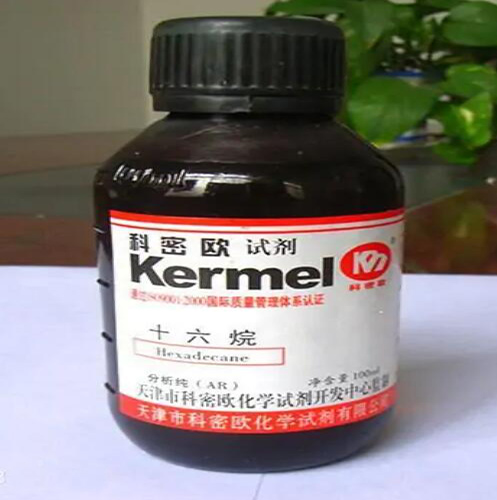The synthetic method of n-hexadecane
Introduction
N-hexadecane is a white solid or a colorless liquid[1]. The melting point is 18.2°C, the boiling point is 286.79, the flash point is 135°C, the ignition point is 202°C, and the density is 0.7734 g/cm³. The chemical formula of n-hexadecane is C16H34 and the molecular weight is 226.44. N-hexadecane is miscible with ether, petroleum ether and chloroform, slightly soluble in hot ethanol, insoluble in water. for solvent.

Picture 1 A bottom of N-hexadecane
The synthetic method of n-hexadecane
N-hexadecane can be obtained by reducing iodohexadecane with zinc powder in an acidic medium: in the laboratory, glacial acetic acid is added with iodohexadecane and zinc powder, saturated with dry hydrogen chloride, and then heated for reaction. The resulting hexadecane floats on the liquid surface, and the finished product is obtained by distillation under reduced pressure.
Preparation method: In a reaction flask equipped with a stirrer, a reflux condenser, and a ventilation conduit, add 920 mL of glacial acetic acid, 327 g (1 mol) of zinc powder, and 352 g (1 mol) of 1-iodohexadecane (2) in turn, and slowly pass Dry hydrogen chloride gas was introduced until saturation. After stirring in a steam bath for 5 hours, cooling, and then introducing dry hydrogen chloride gas. This was repeated for a total of 25h. After cooling, the upper layer of oil was separated, and the residue was poured into 3L of water. The zinc powder was filtered off, and the filter residue was washed with water and ether in turn. The filtrate was extracted with ether (500 mL×2). The ether extract was combined with the oil fractionated above. Wash with 20% sodium hydroxide liquid and water in turn, dry with anhydrous sodium sulfate, fractional distillation under reduced pressure, collect fractions at 156-158°C/1.85kPa to obtain n-hexadecane①(1) 192g, yield 85%. Note: ① 1-bromohexadecane can also be used instead of 1-iodohexadecane. [3]
In order to prepare chromatographically pure n-hexadecane, nitrogen gas can be used as the carrier gas, and its crude product can be injected into a preparative gas chromatograph equipped with a squalane/white diatomite-supported stationary phase column, and its main peak components will be collected by separation, and then Pour into glass ampoules and seal.
Properties and stability
1. Use and store according to specifications, without decomposition, avoid contact with oxides
2. Exist in flue-cured tobacco leaves and smoke.
Storage method
1. Store in a cool, dry and well-ventilated warehouse.
2. Keep away from fire and heat sources. Protect from direct sunlight. Package is sealed.
3. It should be stored separately from acids and edible chemicals, and should not be stored together. Storage areas should be provided with suitable materials to contain spills.
Toxicological data
1. Skin/eye irritation data: Standard Draize test Direct contact with skin in adult men: 50 mg/48Hreaction severity: severe; Standard Draize test for direct skin contact in rats: 100 mg/24 Hreaction severity: severe; Standard Draize Test Rabbit Direct Skin Contact: 100 mg/24Hreaction severity: Severe; Standard Draize test pigs in direct contact with skin: 50 mg/48Hreaction severity: severe; Standard Draize Test Guinea Pig Direct Skin Contact: 100 mg/24 Hreaction severity: Severe;
2. Acute toxicity: Intravenous LCLo in mice: 9821mg/kg, behavior-altered sleep time (including altered righting reflex)
3. Ecological data. The substance may be hazardous to the environment and special attention should be given to water bodies.
Major hazards
Health Hazards: Vapors are irritating to the upper respiratory tract, and inhalation of high concentrations is irritating. Direct aspiration of liquid into the lungs can cause chemical pneumonitis. Harmful if taken orally. Irritating to eyes and skin.
Environmental Hazards: Harmful to the environment and can cause pollution to water bodies.
Explosion Hazard: This product is flammable and irritating.
Hazardous characteristics: In case of high heat, open flame or contact with oxidants, there is a risk of burning
The main purpose
N-hexadecane was used as a solvent, a gas chromatography comparison sample, and a standard substance for the determination of diesel combustion quality. The cetane number of diesel oil is equal to the body percentage of decabane contained in standard fuel (a mixture of cetane and a-methylnaphthalene) when the combustion quality is the same as that of the diesel under evaluation under specified working conditions. The cetane number is between 40-55. In recent years, 2,2,4,4,6,8,8-heptamethylnonane (HMN), which has been used for synthesis instead of a-methylnaphthalene, is used as the standard substance, and its cetane number is 15. The cetane number of standard fuel is calculated by the following formula: cetane = 100 × (% hexadecane) + 15 × (% HMN) such as a mixture containing 35% hexadecane and 65% HMN, base cetane number is: 100×0.35+15×0.65=45. N-hexadecane is used as a gas chromatography reference substance and a fixed solution and solvent. Also used in organic synthesis.
Reference
1 Research progress of cetane number improver[J]. Yan Feng, Wei Yi, Jiang Heng, Liao Kejian, Zhao Chongfeng, Zhang Donglin. Journal of Fushun Petroleum Institute. 2001(04)
2 Influence of Cetane Number on Combustion and Emission Performance of Euro-IV Diesel Engine[J]. Chen Wenmiao, Wu Fujia, Wang Jianxin, Shuai Shijin. Internal Combustion Engine Engineering. 2008(06)
3 Prediction of cetane number and density by hydrocarbon composition of diesel oil[J]. Ling Wen, Lv Dawei. Petrochemical Technology and Application. 2004(03)
See also
Lastest Price from N-Hexadecane manufacturers

US $1.00/g2025-06-02
- CAS:
- 544-76-3
- Min. Order:
- 1g
- Purity:
- 0.99
- Supply Ability:
- 20 tons

US $0.00-0.00/KG2025-04-15
- CAS:
- 544-76-3
- Min. Order:
- 1KG
- Purity:
- 99%
- Supply Ability:
- 500000kg


